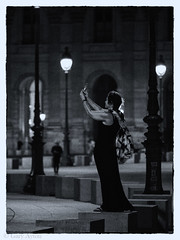Another critically important functionality is being able to set a custom white balance (WB) easily.
This will save you a lot of headaches, particularly shooting in jpeg only mode or even in RAW mode when shooting color-sensitive subjects such as portraits when there are no neutral tones to do a WB correction in RAW development.
Most cameras still have trouble with tricky light sources, especially artificial lighting, so your results will be much better in these situations if you take control of the white balance – and the easiest way is often via a custom white balance.
All procedures below assume you are taking a custom WB by taking a photo of a neutral gray card illuminated by the lighting that will be on your subject.
First the Olympus E510 using “one-touch WB”:
- I always have my E510 set so one-touch WB (rectangle and two triangles icon) is allocated to the Fn button – see menu item wrench 1, Fn button – this makes custom WB even easier – becoming just one step:
- hold the Fn button down and the LCD will tell you to aim the camera at your sheet and while holding the Fn button down, press the shutter button
- if the shot was successful it then displays the image and asks if you want to accept this WB, just hit OK button to accept it
- the E510 is now in one-touch WB mode using your preset WB you have just created until you either replace it by repeating this or changing WB mode via the WB button on the rear of the camera
- unlike the other cameras here, the E510 does not allow storage of multiple custom WB settings, but I tend not to rely on old stored preset settings anyway on my Canon 1DMIII so I don’t miss this feature
- also, the E510 does not allow you to extract WB data from a previously taken photo and assign it to a preset WB – however, this is not a feature that I have missed
The Canon 1DMIII method:
- like many processes on a pro camera like this, it is NOT intuitive like the E510 and you need to read the manual as the on-screen instructions don’t help, but here is how you do it:
- set WB mode to preset by pressing FUNC button and using rear dial to choose preset mode and then use the top dial to choose which preset number (1-5) to use or override
- now the non-intuitive part, hold the FUNC button down and press the button to its right (the lock/microphone button) and the preset number will start flashing inside a bracket, while this is flashing, press the shutter button to take the shot and the WB setting is stored to that preset number. Half press the shutter to go back to shooting mode.
- OK, its fairly fast and gives you options of 5 settings quite easily, but if you have forgotten how to do it and you don’t have the manual, good luck working it out!
Now the Nikon D90:
- go into custom WB mode (Nikon’s “preset WB”) by pressing WB button and rotating rear main command dial to choose PRE which will be displayed on the top control panel
- release the WB button and now the non-intuitive part – press it again until the PRE icon starts to flash, you then have 6 seconds to take a photo by pressing the shutter button to set the WB.
- if the photo was acceptable, the control panel will flash “GOOD” for 6 secs and the setting will be stored in preset d-0 setting (there are 4 other presets d-1 to d-4 which you can later copy the d-0 setting to for future use).
- to use this d-0 setting, you press the WB button and rotate the sub-command dial until d-0 is dsplayed in the control panel
- unfortunately, unlike Olympus, Nikon did not see fit to create a one-touch WB mode which can be allocated to the multipurpose FUNC. button
Well I don’t know about you, but I have got to say, the Olympus method is brilliantly simple as long as you have allocated one-touch WB to the Fn button and remember that you just need to press it and follow the simple instructions.
There are no such simple instructions on the Canon or Nikon, so bring your manual with you!










